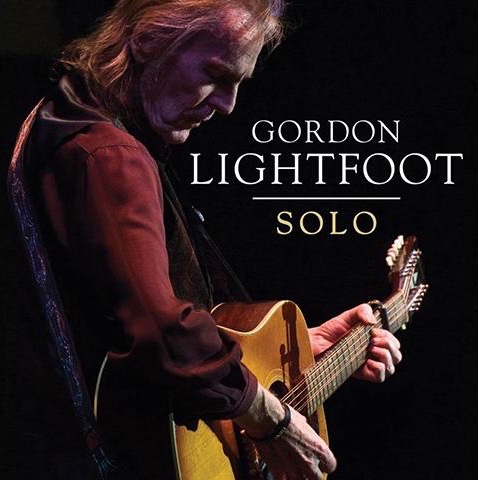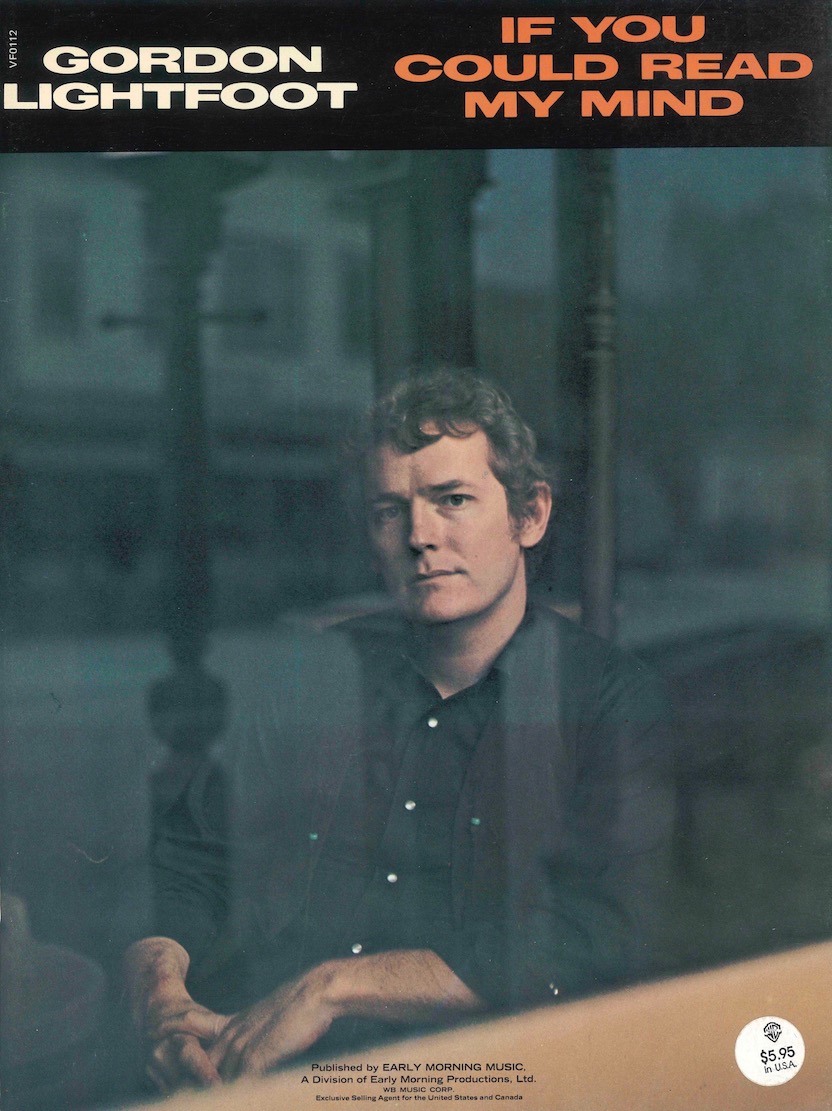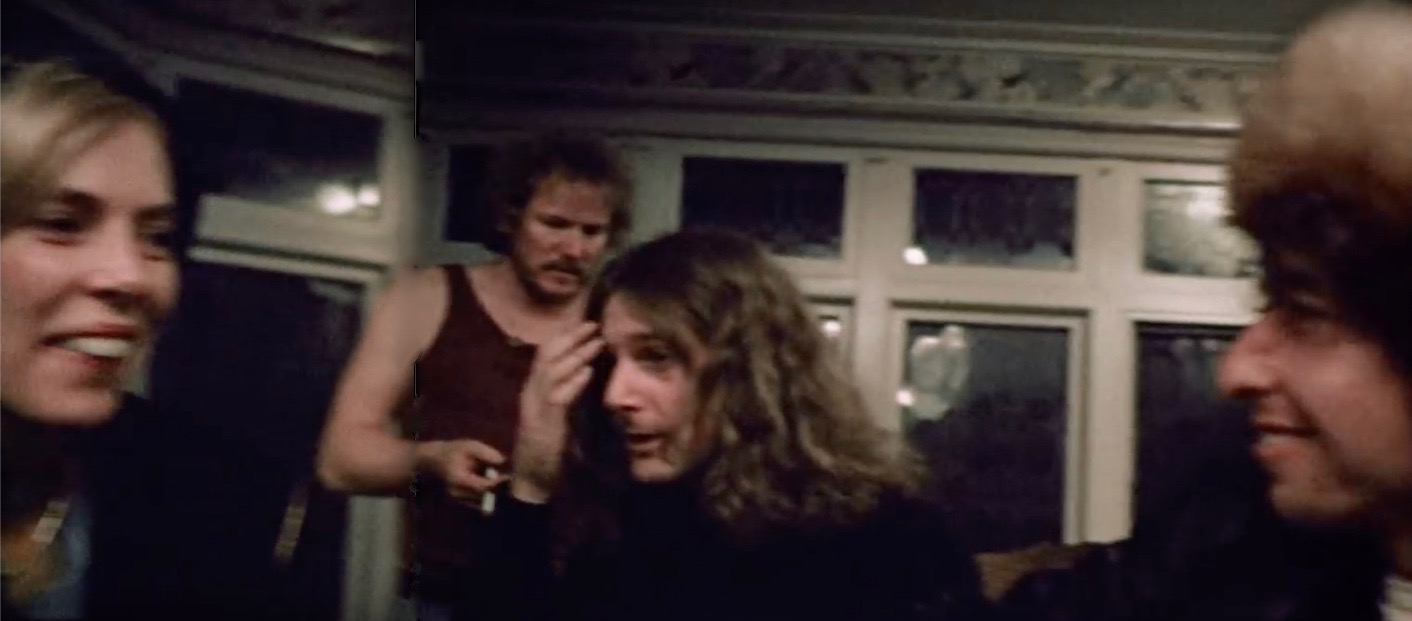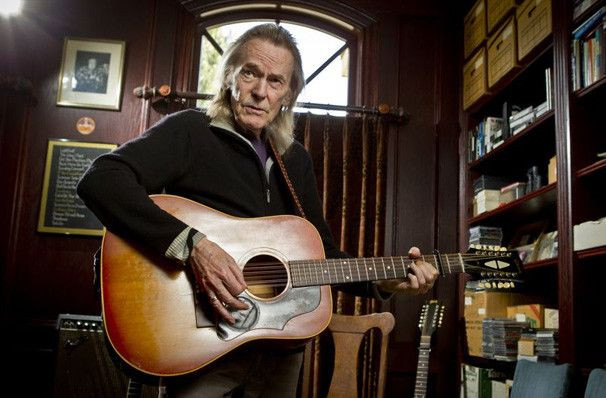Gordon Lightfoot Book, Music and More!
Gordon Lightfoot - Just Like a Paperback Novel
I’m driving north up Toronto’s Bayview Avenue on a winter’s night in early January. I turn east on Post Road and into the Bridle Path neighbourhood, an ultra-posh enclave known as “Millionaire’s Row.” I slow down opposite Rapper Drake’s monster palace, complete with indoor basketball court, and turn toward the stately home that belongs to Gordon Lightfoot.
Much had transpired since the publication of my book, Lightfoot. For one thing Lightfoot reached the milestone age of 80, celebrating with a benefit concert in his hometown of Orillia. For another, he was in the spotlight for a feature-length documentary that had him discussing his storied career and timeless back catalogue of songs, along with fans like Geddy Lee, Anne Murray and Alec Baldwin. Plus, I’d heard he’d become a great-grandfather, in addition to being the father of six children (by four mothers) and a grandfather to another five. Think of him as Papa Lightfoot, the last of the troubadours and the grand old man of Canadian song.
As I make my way up the winding driveway, I wonder what awaits. It’s a new year and new decade. What will be the latest chapter in the legendary singer-songwriter’s tale, and will the notoriously reticent artist be willing to open up more deeply? I park out front. There’s plenty of room because Lightfoot parks his 2001 Chevy Monte Carlo in the garage ’round back. I walk across lightly fallen snow and ring his doorbell. Already something’s different. A weathered lawn chair is folded up and set to one side. On previous visits, Lightfoot would often be sitting outside in that chair, waiting for me and smoking a cigarette—even in the dead of winter.
 The door opens and Lightfoot’s wife, Kim, greets me enthusiastically. She leads me to the music room just off the large, marbled-tiled foyer. This is Lightfoot’s lair, a dark, wood-panelled room full of Martin and Gibson guitars, Fender and Traynor amps, vintage cassette recorders and shelves full of tapes and notebooks containing the set lists of concerts going back decades. “Have a seat,” Lightfoot tells me, pointing to a small wooden writing desk. “Let’s get down to business.”
The door opens and Lightfoot’s wife, Kim, greets me enthusiastically. She leads me to the music room just off the large, marbled-tiled foyer. This is Lightfoot’s lair, a dark, wood-panelled room full of Martin and Gibson guitars, Fender and Traynor amps, vintage cassette recorders and shelves full of tapes and notebooks containing the set lists of concerts going back decades. “Have a seat,” Lightfoot tells me, pointing to a small wooden writing desk. “Let’s get down to business.”
I’m there, in part, to learn more about Solo, Lightfoot’s 21st studio album and his first since 2004’s Harmony, and a collection of lost recordings from the same era. Lightfoot found them last year while clearing out his Early Morning Productions office on Yonge Street. What’s most remarkable about the recording’s 10 songs is their stark intimacy, both lyrically and musically. More on the album later.
I’m also there to gain fresh insights into the icon, composer of such classics as “Sundown,” “The Wreck of the Edmund Fitzgerald” and “If You Could Read My Mind” and the man who even Bob Dylan once called a mentor. “Tell me something surprising, Gord,” I say right off the bat, “something you’ve never told another interviewer.” He stands up, still spry at 81 and lean as a whippet, and begins thumbing through the Webster’s dictionary he keeps on his bigger desk. Finding the word he’s looking for, he spells out: “H-E-M-A-T-O-M-A.” Then he continues with the definition: “A local tumor or swelling filled with an effusion of blood, between the muscle and the epidermis.” I know all about it. Last July, Lightfoot badly injured his left leg when he walked into a piece of exercise equipment at Toronto’s Cambridge Club, the fitness centre he’s been going to religiously since quitting drinking in 1982. The swelling was so bad he needed surgery, forcing Lightfoot to cancel tour dates in the latter part of the year, something he hated doing.
What I didn’t know was that Lightfoot is anemic and, perhaps as a result, the hematoma still hasn’t fully healed. Lightfoot is wearing shorts that reveal his bandaged leg and wants to tell me all about the wound—in graphic detail. “It was a weeper, a real weeper” he exclaims almost gleefully, insisting I look at two photos, before and after surgery, something I cannot un-see. “It left a gaping hole large enough to put a golf ball inside!” Lightfoot may be an internationally renowned artist, whose songs have been covered by everyone from Elvis Presley to Barbara Streisand, but, at 81, he’s just like the rest of us—happy to share his various health dramas.
Lightfoot rhymes off his other ailments, including dry vasomotor rhinitis, a chronic inflammation of the sinus passages. It affects his singing voice and he needs nasal spray to perform. He’s had two brushes with death—one real, the other a hoax. In September 2002, he began getting severe stomach pains right before an Orillia concert. His sister, Beverley, found him lying on the floor of his dressing room in agony. He had to be airlifted to Hamilton to undergo emergency surgery and a tracheotomy due to a life-threatening ruptured abdominal aortic artery. He spent six weeks in a coma and ultimately had four operations over the course of many months. But Lightfoot, miraculously, bounced back. Just two years later, he released Harmony and slowly returned to performing. In 2006, he suffered a transient stroke that temporarily compromised his ability to fingerpick, but he “pressed on,” as he likes to say, and fully recovered. The death hoax came four years later, when a false report of his passing went viral—Lightfoot heard the news item on the radio while driving to his dentist and called in to quash it. Ever since, he’s joked in concert that, like Mark Twain, reports of his death have been greatly exaggerated.
Lightfoot has always been a heavy smoker—he started when he was 15 and singing in Orillia barbershop quartets. He had his last cigarette in late 2018. What motivated him was unexpected. It wasn’t his emphysema diagnosis (which his mother, Jessica, also a heavy smoker, died from in 1998), but a pact he made with his youngest son Miles. They decided they would quit smoking together. Miles bailed, but Lightfoot stuck it out—proof of his iron-clad will, not to mention his strong will to live. It also explains the folded lawn chair on the porch. “I haven’t quit smoking everything,” he explains with a grin, acknowledging his taste for legal cannabis, “although I may eventually switch to edibles.”
 All the talk of health brings us around to Kim, his 59-year-old third wife whom he married on December 19, 2014 at Toronto’s Rosedale United Church where Lightfoot, for many years, has sung at their Christmas Eve service. “Kim’s a very helpful and good person, in so many ways,” he says. “She travels with me on tour. Whenever I’ve had a health issue, she’s been there. She looks after me and that means my family doesn’t have to do it—they should consider themselves lucky! She goes to the pharmacy, looks after my medications, goes with me to all appointments and she’d rather sleep on the hospital floor than leave the hospital if I’m in there—and you can print that!”
All the talk of health brings us around to Kim, his 59-year-old third wife whom he married on December 19, 2014 at Toronto’s Rosedale United Church where Lightfoot, for many years, has sung at their Christmas Eve service. “Kim’s a very helpful and good person, in so many ways,” he says. “She travels with me on tour. Whenever I’ve had a health issue, she’s been there. She looks after me and that means my family doesn’t have to do it—they should consider themselves lucky! She goes to the pharmacy, looks after my medications, goes with me to all appointments and she’d rather sleep on the hospital floor than leave the hospital if I’m in there—and you can print that!”
Lightfoot’s emphasis speaks volumes about the underlying tensions in his romantic and matrimonial entanglements, past and present, which he still grapples with daily. He started dating Kim, a Hollywood background actor from Mason City, Iowa, in 2008. At the time, Lightfoot and his second wife, Elizabeth (mother of Miles and his sister, Meredith), separated in 2003, shortly after his near-fatal aneurysm. They divorced eight years later but still communicate. Has Lightfoot been able to maintain good relations with his ex-wife? “Well, I handle that as best I can, but I’m really not going to touch on that subject,” he replies, fearful of upsetting Kim. It’s clear from everything I’ve witnessed that Kim is far more than helpful, and that she and Lightfoot have a good marriage. Nonetheless, Lightfoot doesn’t say too much about her in our interview to dodge a possible “commotion” with Elizabeth.
All of this sheds light on the infamous Lightfoot reticence and why journalists have always found him so tight-lipped about his personal life. To Lightfoot, interviews are a minefield and he navigates them assiduously, careful not to step on any potentially explosive topic. With me, he even used the words “powder keg,” to explain why he suddenly clams up about the women in his life. And he worries that if he says too much about any of them—even going back to his first wife, Brita (mother of Fred and Ingrid), his tumultuous affair with Cathy Smith or his common-law marriage to Cathy Coonley (mother of Eric)—the words will “come back to haunt me.”
 Speaking of ghosts and haunting, one of Lightfoot’s most famous songs, the 1970 hit “If You Could Read My Mind,” covered by everyone from Liza Minnelli and Olivia Newton-John to Glen Campbell and Neil Young, was written amid his dissolving six-year marriage to Brita. “It was a kind of unrequited love song, partly due to love’s roller coaster,” Lightfoot has explained. “Marriages that don’t succeed, unfortunately—I guess it relates to that.” When pressed, he recognizes that his affairs with other women caused that marriage to fail. It’s why he no longer performs his earliest hit, 1965’s “For Lovin’ Me,” with its boast: “I’ve got a hundred more (women) like you, I’ll have a thousand before I’m through.” Says Lightfoot: “That was chauvinistic.”
Speaking of ghosts and haunting, one of Lightfoot’s most famous songs, the 1970 hit “If You Could Read My Mind,” covered by everyone from Liza Minnelli and Olivia Newton-John to Glen Campbell and Neil Young, was written amid his dissolving six-year marriage to Brita. “It was a kind of unrequited love song, partly due to love’s roller coaster,” Lightfoot has explained. “Marriages that don’t succeed, unfortunately—I guess it relates to that.” When pressed, he recognizes that his affairs with other women caused that marriage to fail. It’s why he no longer performs his earliest hit, 1965’s “For Lovin’ Me,” with its boast: “I’ve got a hundred more (women) like you, I’ll have a thousand before I’m through.” Says Lightfoot: “That was chauvinistic.”
Lightfoot had no shortage of affairs during his heyday, and his wild ways were fueled by drugs and booze, sometimes a bottle of Canadian Club a day. His 1974 chart topper “Sundown” was a taut tale of jealousy, written during his time with Cathy Smith, a beautiful and notorious flirt and sometime backup singer who later served prison time for injecting John Belushi with a fatal dose of heroin and cocaine. But Lightfoot dramatically changed his ways and these days often speaks of being in a state of “repentance.” Along with no longer singing “For Lovin’ Me” (which catapulted his career when it was covered by Peter, Paul & Mary), he re-wrote the words to “If You Could Read My Mind” at the insistence of his daughter Ingrid. Now when he performs the classic song, he sings “the feelings that we lack” rather than “the feelings that you lack,” acknowledging that marriage is a two-way street.
Part of Lightfoot’s repentance involves making time for all of his kids, whom he neglected when his career was a constant cycle of writing, recording, touring, partying, sailing and then canoeing, drying out and getting fit for the next round of writing, recording and touring. Today, his complex schedule would benefit from a flow chart, mapping out where and when he sees the various members of his large extended family. His two eldest children, Fred, 56, and Ingrid, 54, are in the Toronto area and each have two kids of their own. His sons Eric, 38, and Galen, 44, are on out the West Coast, but Lightfoot stays in close touch. Galen’s mother was a waitress at the Troubadour club in Los Angeles, with whom Lightfoot had an affair in the ’70s. Miles, 30, lives in Thornhill, while Meredith, 25, who goes by her mother’s maiden name of Moon, has moved about while pursuing her musical ambitions as a singer-banjoist. “We visit back and forth,” says Lightfoot, about his children, “they come to me or I go to them. If we’re not doing that then we speak on the telephone. A bit of emailing goes on between Kim and a couple of the kids, because I don’t use computers.”
Our attention shifts to Solo, which is by turns wistful and whimsical. For the first time in Lightfoot’s nearly 60-year recording career, there’s no accompaniment—just his unvarnished voice and ringing acoustic guitar. Never has he sounded so raw and vulnerable. The songs are soul baring, full of candid reflections on life and love, taking stock of his past. At one point, Lightfoot considered calling the album Bare Tracks, while his precocious four-year-old granddaughter, Lennox, suggested: Bare Ass Naked. Naked, indeed. The album opens with the nostalgic “Oh So Sweet,” a steady fingerpicked number that looks back on good times amid regrets about “things said and done.” The gently strummed “E-Motion” finds Lightfoot confessing to being a “king-sized fool,” while on the bluesy “Dreamdrift” he claims to be “still as crazy as I always have been.” There’s plenty of variety in themes, with philosophical ruminations like “Return Into Dust” and “The Laughter We Seek” and such humorous tunes as “Just a Little Bit,” which questions a litany of routine chores and surroundings, including the CN Tower. There are several uptempo numbers Lightfoot quaintly calls “toe-tappers” and romantic ones he describes as “lovey-dovey.”
I ask what happened to “It Doesn’t Really Matter” and “24 Hour Blues,” two more recently written songs he’d played me several years ago. Lightfoot, ever the perfectionist, says the former “simply wasn’t good enough” to include, while the latter “bit the dust” because it had a line in it that he worried might be offensive to one of his doctors—I kid you not. So I change gears and ask if Lightfoot can give an example of the good times with a past lover that he hints at on “Oh So Sweet.” “Oh jeez,” he says, “I don’t want to do that! People read things and then want to know this and that. They get mad at you when they read about your past and you don’t want to cause some kind of confrontation. I try and tell them it’s poetic licence, but that doesn’t work with Kim. She believes I’m relating back to a former relationship and gets offended.” Kim later texts me, admitting that while she finds it hard listening to her husband’s love songs about other women, she has come to realize she must share him: “No one can have all of Gordon—we each have our own unique love story with him.”
It’s the songwriter’s curse, I tell Lightfoot. Couldn’t a lover in one of your songs be a composite of different women, I ask, and the narrative be set in a mix of times and places? “Yes, indeed!” Lightfoot replies, excitedly. “That’s poetic licence!” The man with the long, lanky hair sitting across from me suddenly goes quiet. He is staring down at his hands. I notice the long, slender fingers and finely manicured nails, essential for fingerpicking, the liver spots that dot the back of his hands and a rubber wristband from Stagecoach, the California-based country music festival he played in 2018. Reading his mood, I decide to lighten the conversation.
 Knowing that Lightfoot has long been friends with Dylan, going back to 1965 when they shared a manager in Albert Grossman, I ask if he’s seen Martin Scorsese’s pseudo-documentary about Rolling Thunder Revue, Dylan’s celebrated travelling circus tour with musical friends that featured Lightfoot when it stopped in Toronto. He hasn’t watched it yet. I tell him there’s a scene with Dylan, Joni Mitchell and ex-Byrd Roger McGuinn jamming on the second floor of Lightfoot’s Rosedale mansion, where the Rolling Thunder entourage partied wildly after one of the shows. You can spot Lightfoot in the background, being the good host and trying to stay out of the eye of the camera. “Yeah, they were all there at the house,” Lightfoot recalls. “Bob’s road manager, Bob Neuwirth, came over in advance to ask if they could come by for drinks. I said sure and called my sister Beverley and other family members to see if they’d help out. I got Ingrid and Cathy Coonley involved. They were all there, all the cast, Ronnie Hawkins and even Allen Ginsberg. It was quite a gathering.” Typical Lightfoot understatement. The party was a pure rock ’n’ roll bacchanal that perfectly capped the tour’s triumphant stop in Toronto. “Yep, I should see the film,” Lightfoot says, “I’ve been told I’d like it.”
Knowing that Lightfoot has long been friends with Dylan, going back to 1965 when they shared a manager in Albert Grossman, I ask if he’s seen Martin Scorsese’s pseudo-documentary about Rolling Thunder Revue, Dylan’s celebrated travelling circus tour with musical friends that featured Lightfoot when it stopped in Toronto. He hasn’t watched it yet. I tell him there’s a scene with Dylan, Joni Mitchell and ex-Byrd Roger McGuinn jamming on the second floor of Lightfoot’s Rosedale mansion, where the Rolling Thunder entourage partied wildly after one of the shows. You can spot Lightfoot in the background, being the good host and trying to stay out of the eye of the camera. “Yeah, they were all there at the house,” Lightfoot recalls. “Bob’s road manager, Bob Neuwirth, came over in advance to ask if they could come by for drinks. I said sure and called my sister Beverley and other family members to see if they’d help out. I got Ingrid and Cathy Coonley involved. They were all there, all the cast, Ronnie Hawkins and even Allen Ginsberg. It was quite a gathering.” Typical Lightfoot understatement. The party was a pure rock ’n’ roll bacchanal that perfectly capped the tour’s triumphant stop in Toronto. “Yep, I should see the film,” Lightfoot says, “I’ve been told I’d like it.”
Lightfoot’s a movie buff (his favourite film is 1984’s Amadeus, about the rivalry between composers Wolfgang Amadeus Mozart and Antonio Salieri), so I ask if he’s seen Quentin Tarantino’s Once Upon a Time in Hollywood, which is set in 1969 and features the Manson family as the backdrop. I thought Lightfoot would be interested. “I’ve watched half of it,” he says. “I don’t even like to think about how I was there that night in the Hollywood Hills.” Lightfoot was staying at his friend Jack Nicholson’s guesthouse on Mulholland Drive, in bed with Helena Kallianiotes, the striking belly dancer-actress who’d appeared in the Monkees’ experimental movie Head, which Nicholson had directed. They woke up the next morning and freaked out when they learned the Manson murders had taken place just a couple of blocks away.
 Despite the extraordinary journey his career has taken him on and all the awards and success he’s achieved, Lightfoot remains refreshingly unaffected by fame. While always ambitious and competitive, he’s stayed down-to-earth, humble and lazar-focused on his marriage, his family and touring with his band members, some of whom he’s been with longer than any of his wives. He’s a creature of habit and doesn’t like change or surprises. Loyalty and hard work are just two of the small-town values he inherited from his dad, who ran Orillia’s laundry service. Lightfoot’s had the same booking agent (Bernie Fielder), barber (Sandy Bozzo) and bass player (Rick Haynes) since the 1960s. He’s a details-oriented guy, possibly on the spectrum, and constantly makes lists of tasks, responsibilities and tour plans. After performing an astonishing 81 shows in 2018 and 43 last year, he and his group of Haynes, drummer Barry Keane, keyboardist Michael Heffernan and guitarist Carter Lancaster have some 50 dates booked through to the end of 2020.
Despite the extraordinary journey his career has taken him on and all the awards and success he’s achieved, Lightfoot remains refreshingly unaffected by fame. While always ambitious and competitive, he’s stayed down-to-earth, humble and lazar-focused on his marriage, his family and touring with his band members, some of whom he’s been with longer than any of his wives. He’s a creature of habit and doesn’t like change or surprises. Loyalty and hard work are just two of the small-town values he inherited from his dad, who ran Orillia’s laundry service. Lightfoot’s had the same booking agent (Bernie Fielder), barber (Sandy Bozzo) and bass player (Rick Haynes) since the 1960s. He’s a details-oriented guy, possibly on the spectrum, and constantly makes lists of tasks, responsibilities and tour plans. After performing an astonishing 81 shows in 2018 and 43 last year, he and his group of Haynes, drummer Barry Keane, keyboardist Michael Heffernan and guitarist Carter Lancaster have some 50 dates booked through to the end of 2020.
Having dodged death and overcome medical crises, not to mention outlasting most of his musical contemporaries by sticking to his tried-and-true folk sound, Lightfoot may be pop’s ultimate survivor. How long will he keep going? “To quote my friend Bob Dylan,” he replies, “‘work while the day lasts, because the night will come when you can no longer work.’ I’ve simply never wanted to retire.”
It’s getting late and I know that Lightfoot, the fitness freak, turns in early and is at the gym every day by 10, so I finish off by asking him whether he’s learning to like himself more. “I guess I think I’m doing okay,” he says, “but I always think I could do better. I don’t think I try hard enough with my kids. I’m still trying to make up for the way I treated their mothers.
“Have I learned anything?” Lightfoot continues. “Yeah, I’ve learned to control my emotional self a little bit better when arguments occur. Anger can kill you—kill you right where you’re standing—with a stroke. I try to listen when I talk to people, try to get them talking about themselves. But with wives and mates…I sometimes find it hard to get my point across with women.”
Finally, I ask Lightfoot if he’s still dealing with personal demons and whether he’s been able to make peace with his life. Lightfoot takes a big breath and sighs: “God, I don’t know.” Then he adds, in a voice that’s barely above a whisper: “I don’t actually know if I’ve made peace with anything.”
Lightfoot by Nicholas Jennings is available in paperback and audio book.
This article was originally published in Zoomer magazine March 2020
By accepting you will be accessing a service provided by a third-party external to https://www.nicholasjennings.com/




